
SpaceX Starship


You are here: Space Explorers > Commercial Space > SpaceX > Astra's Starship Home Page
Like Astra's on Facebook
On this page: Starbase | Raptor Engines | Hot Staging | Thermal Protection | Hot Staging | Environmental Assessment | Starship Under Development: Version 2 | Version1 | Starship Test Flights | Upper Stage Tests | Early Starship Prototypes |
Go directly to the Starship Prototype Testing Page
How could Astra ever resist talking about SpaceX and Elon Musk who are building a giant Starship to start colonizing Mars? Starship is developed at SpaceX's Starbase facility located at Boca Chica Texas. Starship is a stainless steel behemoth spacecraft designed to launch up to 100 people on the trip of a lifetime - - to the surface of Mars. The Starship launch system is a 2-stage vehicle, massive enough to take humans to the red planet. The first stage is the Falcon Super Heavy booster that is powered by multiple Raptor engines - - 33 in the current version. The second stage is the Starship spacecraft that has three Raptor engines for operating in Earth's atmosphere and three optimized for the vacuum of space.
Both stages are made of stainless steel and are expected to be fully reusable. When Starship is returning to Earth, the upper stage must be protected from atmospheric entry and so it has a thermal protection system on its "belly". It is comprised of small (30cm) black hexagonal pieces that give a honeycomb-like effect. Special pieces must be used on various specialized areas (such as the nose cone.)
Starship was rolled out by Elon Musk at the International Astronautical Congress in 2016. Unnamed at the time, Elon presented it as the "BFR" or "Big Falcon Rocket", though some say the acronym stood for something else. SpaceX began testing for the rocket that would eventually become Starship in a series of prototype tests.
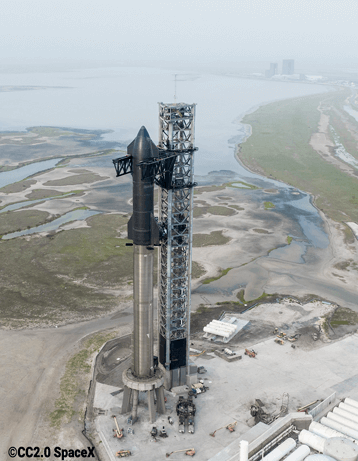
Starship has caused a lot of excitement as the development of the project is in clear view at the SpaceX facility in Boca Chica, TX. Enthusiasts have been able to watch as the Starship project meets its developmental milestones. Engine tests are often viewed by thousands and many YouTube channels and websites have sprung up to watch the development of the vessel that is expected to take humans to Mars. Before launching to Mars, however Starship will take humans to the surface of the Moon under NASA's Artemis Project.
On June 14, 2022, the Federal Aviation Administration (FAA) approved a final environmental assessment of the proposed SpaceX Starship spacecraft and Super Heavy rocket program in Boca Chica, TX. Although SpaceX is required to meet 75 conditions, this means that SpaceX will be able to conduct orbital launches at the Boca Chica Starbase facility.
Starships that return to Earth are expected to be caught by two massive arms that are affectionately called, "chopsticks". These arms hold the Starship and its Falcon Super Heavy booster on the orbital launch mount. This system will be tested when SpaceX is able to launch and retrieve a Starship on return to the launchpad.
For more details on Starship, download the Starship User's guide at SpaceX.com
Check out SpaceX's Starship web page!

Keep watching here for updates on SpaceX's Starship launch system. The Starship Prototype Testing page has a complete account of each test launch. Check the on site SpaceX Info Links page for some of the sources used to keep up with the amazing pace! You can find various livestreams that are continuously operating on YouTube or link to them from this page on the What About It? website on available livestreams.
#AstrasStargate #ImaRocketFan
Elon Musk posted this image of starship boosters 10, 11, and 12 as they are being worked on in the high bay at Boca Chica, Texas. The boosters are seen between two section of Booster 13 that were stacked shortly after this image was taken.

☆ ☆ ☆
Boca Chica, Wow!
In May 2025, Boca Chica became officially became Starbase, Texas!
Boca Chica started out as a vacation spot for those who could afford second homes. A small village located near the mouth of the Rio Grande, also known as Rio Bravo de Norte. It is a swampy area and also sandy because it is part of the river's delta. Most of the water that feeds into the sea at this location is provided by the tributary, Rio Conchos. In the dry months, the flow from the river may stop completely.
SpaceX moved into Boca Chica in 2014, and began building its rocket manufacturing area, often called the build area, and its launch site. Today a towering high bay structure in the build area stands around 280 ft. (85 meters) tall. It was built to hold giant Starships and tall rocket boosters. Starship is 160-feet tall and 30m in diameter, the booster is somewhat smaller in diameter, but it stands 230-feet tall. Together they stand almost 400-feet tall. That's 120 meters in metric! The build site also includes a midbay that is 150-feet or 45m high. There is also a low bay building. The SpaceX complex has grown steadily over the last seven years. Other structures include long buildings called, tents, that allow SpaceX to build nose cones, the stackable rings that make up sections of Starship and Falcon Heavy, and more. Near the build area, there is a scrap yard, a fuel production site and other buildings.
North of the build site, SpaceX installed two 9 m (30 ft.) S-band tracking station antennas at the site in 2016 to 2017. These antennas were formerly used to track the Space Shuttle during launch and landing. SpaceX acquired the antennas from NASA and they had to be "certified" by NASA before they could be put into operation. In 2018, they became operational for tracking crewed Dragon missions. Today this area is called the SpaceX South Texas Tracking Station.
Early tests of Starship were conducted on a simple launch pad, with large cranes that moved the vessels into position for the launch, but Falcon Heavy and Starship require a more robust system. SpaceX has built an orbital launch mount (OLM) that is supported by the launch and integration tower, affectionately called "Mechazilla". Mechazilla is 469 feet tall or 143m, it has two 36-meter long arms made of tubular steel beams. These arms, called "Chopsticks", move up and down along a rail track on the tower. There are 4 giant electric motors that allow the arms to move. The arms can move toward each other, a motion that is controlled by hydraulic cylinders. The plan is for Mechazilla to catch the returning booster after it has performed its launch service and returns to land.
The booster is fueled through a quick disconnect system on the OLM and the Starship is fueled through a quick disconnect arm that is installed on the integration tower. Ground Support Equipment (GSE) at the Orbital Launch Site (OLS) includes 90-foot tall tanks holding liquid methane and liquid oxygen, the propellants used by Starship and Super Heavy. The tanks were made on-site by SpaceX and have the diameter of the Starship. There are eight tanks, counting one tank that holds water. These are protected by mounds of dirt that surround the GSE separating them from the orbital launch area.
Since the first integrate flight test left a significant amount of damage at the orbital launch site, SpaceX has been busy repairing the damages and beefing up the protection for the ground support equipment and water collection. SpaceX has successfully installed a complex water deluge system that will prevent the kind of damage that occurred during the first test. This system includes water-fed steel plates that will cool the engines and avoid injury to the launch mount while the Falcon Super Heavy is firing. Three large water tanks feed the water into the steel-plate system during launch. The system was tested on August 6, 2023 and SpaceX released a video of the test, showing off the water deluge system. Raptors fired for 2.74 seconds and 4 engines shut down during the test.
SpaceX has also decided to convert the Starship to include "hot-fire" system, igniting the Starship stage before the booster ceases to fire near the end of the mission. This method has been used previously to launch other space missions.
For more information, check out Astra's Starship page.
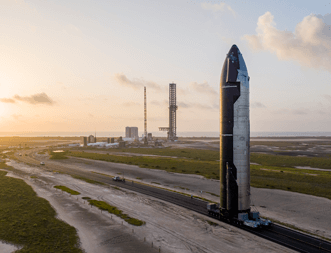
Elon Musk, SpaceX CEO, announced plans to incorporate a new city in the area of Boca Chica, Texas, in March of 2021. Although no such city has yet been chartered, the area near Boca Chica and South Padre island has already been dubbed, "Starbase" by Elon Musk and SpaceX fans. Starbase is actually 2 separate locations, with Starship and Falcon Heavy Boosters being manufactured in one area and launch pads with support equipment in another.
The creation of the South Texas Tracking Station, the build site, and the orbital launch site two miles up the road has spurred growth in the surrounding area. The closest city is Brownsville, TX, a small city with around 100 thousand inhabitants. It is the location of a USA-Mexico border crossing. Across the border is the city of Matamoros, in the Mexican state of Tamaulipas. The greater metropolitan area of these two cities is over 1.3 million. But the SpaceX facility is 20 miles away from Brownsville, down country roads.
There are 3 good reasons why SpaceX decided to build their spaceport in the remote area of Boca Chica. They are location, location, location!
Because of the latitude 25.6 degrees N, launches from Starbase are close to the equator and the site is located in the continental United States of America. It is a remote location and just off the Atlantic ocean so that launches from Starbase do not compromise populated areas.
There are many more details of SpaceX, Starbase, and the future Starship out there on the web. Check out the SpaceX Information Resource Links at Astra's Stargate for resource pages and to find a lot more information on SpaceX and rockets. We follow the YouTube channels of Everyday Astronaut, Marcus House, Scott Manley, and others for SpaceX and space exploration for updates and information.
Since I believe the current craft beer trend has opened fantastic opportunities for American entrepreneurs, and there's nothing more refreshing than a good craft beer, I am pointing Stargate visitors who want to know more about the Starbase Boca Chica story to the Starbase Brewery Stargate Texas Map - - Happy crafting! - - Astra

Elon Musk is working toward his desire to launch humans to Mars. (Himself included, of course!) SpaceX has grown a whole new rocket booster and second stage in preparation for lunar landing and then on to Mars.
Falcon Super Heavy is the booster that is intended to take the SpaceX Starship to the Moon, Mars, and beyond. This behemoth is the most powerful rocket on Earth today, although it still must prove its strength. On April 20, 2023, the Falcon SuperHeavy Booster #7 was launched, carrying the Starship on the first integrated flight test. Although the SuperHeavy showed what it could do, the upper stage, Starship SN24 was not able to separate successfully. Repeated flights have helped to push the development of Starship forward using rapid reiteration.
Raptor Engine
The Falcon SuperHeavy rocket is powered by SpaceX Raptor engines, a full-flow staged combustion cycle rocket engine that SpaceX developed for use with the Falcon SuperHeavy and Starship. Raptor engines began flight testing on Starship prototypes rockets in July 2019, making it the first full-flow staged combustion rocket engine flown. Like the Merlin engine, Raptor was also designed for reuse. The current recovery plan is for the Falcon Heavy to return to the launch stand to be captured by giant robot arms. The first test of a Raptor engine took place in 2016.
Raptor 1 was used to successfully launch 5 Starship prototypes, concluding with Starship 15 that successfully performed the belly flop and landed perfectly. Because reusability and rapid turn around is a must for SpaceX, Raptor2 is significantly different from Raptor1 because the design was simplified to speed up manufacturing. Raptor 2 was first installed on Booster #7 at Boca Chica in May 2022. By June 2022, all 33 engines were installed on Booster 7. Although Raptor 2 is proving its mettle, future versions of the engine may be on the horizon. A newer version of the engine, Raptor3 is now being tested.
Raptor engines are manufactured in SpaceX's plant located in Hawthorne, California, then delivered to the test facility in McGregor, Texas. SpaceX is building a production plant in McGregor as well. Eventually McGregor will produce the Raptor2 and Hawthorne will produce the Vacuum Raptor and other experimental engines. SpaceX plans to build 800 - 1000 Raptor engines per year. This would enable a self-containing colony on Mars.
Raptor 2 is simplified version of Raptor 1 with a large amount of plumbing and sensors removed. There is less test equipment on Raptor 2 due to data gathered by SpaceX's tests on the original version. Raptor 2 has a larger throat diameter that should add more thrust. Some components were combined and eventually SpaceX would like to remove all engine shrouding from the booster to decrease the booster’s mass. Other refinements have decreased the mass of the engines. It is hoped that removing flanges on the engine will increase Raptors thrust to 250 tons.
The latest version of the raptor engine, Raptor 3 was announced by Elon Musk after the first integrated flight test of Starship.
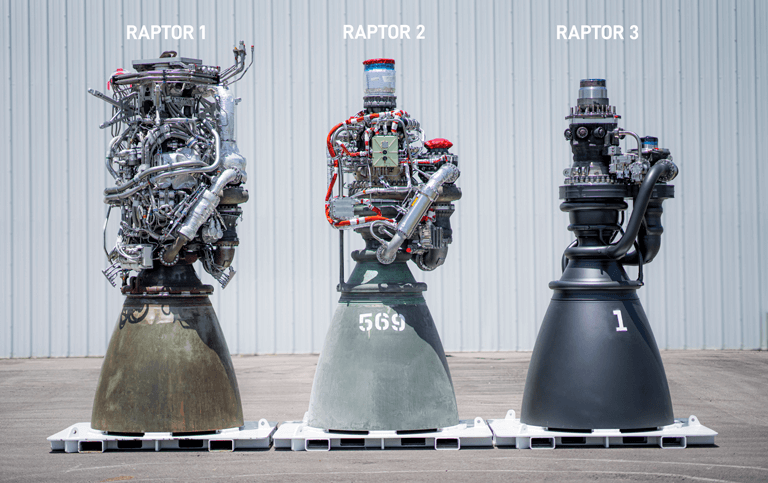
Raptor 1 (sea level variant)
Thrust: 185tf
Specific impulse: 350s
Engine mass: 2080kg
Total mass: 3630kg
Raptor 2 (sea level variant)
Thrust: 230tf
Specific impulse: 347s
Engine mass: 1630kg
Total mass: mass: 2875kg
Raptor 3 (sea level variant)
Thrust: 280tf
Specific impulse: 350s
Engine mass: 1525kg
Total mass:mass : 1720kg

Starship uses ~18,000 hexagonal heat shield tiles to protect it during re-entry called the "Thermal Protection System" or TPS. This system must work flawlessly. There are hundreds of unique tile shapes and sizes that cover the belly of the vehicle, protecting Starship from the heat of re-entry. In an attempt to make the tiles easier to service, most of them are the same shape. They are about 12-inches across and have a hexagonal shape, fitting together like a honeycomb. Tiles use mechanical pins that allows them to move a bit without "chipping." Some areas of Starship also use adhesive, but this is used as minimally as possible. The nose cone is a bit more difficult to cover and there are flap hinges that need more attention.
After Starship flight tests, SpaceX decided to add a white thermal blanket beneath all of the pinned tiles. This blanket, sometimes called, "felt", fills the gaps between the tiles. This can protect the steel from the heating in the small gaps between tiles. The TPS is still undergoing testing and there may be changes to improve the system in the future.

Starship is an awesome rocket that is being developed with the usual SpaceX innovation philosophy. New engines, SuperHeavy first-stage booster, and the second-stage marvel, Starship, are all being built with reusability in mind. After the partial success of the first integrated flight test, Elon Musk announced that Starship's next clever trick was to be "hot staging"!
Hot staging has been used in the past, notably the United States' Titan II rocket that actually started life as a missile, not a lift vehicle. The Soviets, of course, developed rockets that practiced hot staging, including the Soyuz-2 that routinely takes astronauts to the International Space Station. The Soyuz-2 rocket has a lattice structure between the second and third stage. The structure allows the engine of the upper stage to fire just before the separation from the core stage that is still firing below it. A cone-shaped deflector helps to direct the flow of hot exhaust gas from the third-stage engine when it fires up. Of course, the Russian core stage is expendable while Starship will be reusable.
On June 24, 2023, Elon Musk shared this image on "X" (formerly known as "Twitter"), showing the vented interstage and heat shield installed on Booster 9. We've indicated a couple of features on the image with white arrows, notably, three locking structures spaced evenly on the top that will hold the upper-stage Starship firmly to the core-stage SuperHeavy booster. Besides the obvious vents, we've indicated the reinforcing "x-shaped" structure between the serrated vents. Like the Soyuz, the heat shield is conical, with a flat top.
Three sea-level Raptor engines, mounted to the upper stage, will occupy the flat area. These engines gimbal, but the vacuum Raptors do not. It seems inevitable that the vacuum Raptors mounted on the outside will fire off alone, although no one seems quite sure how the hot staging will actually work in practice. That's the innovative part. The exhaust from the engines will travel out the vent while the SuperHeavy booster below must be protected from the energetic exhaust.
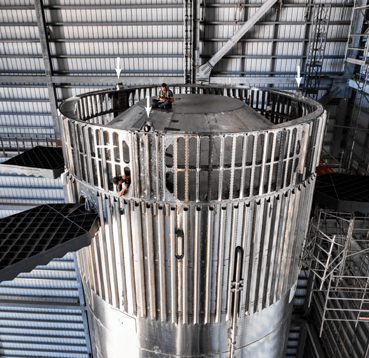
The purpose of hot-staging is to save fuel. No momentum is lost and there is no need to worry about gases intermixing with the rocket fuel. To prevent this, many rockets use ullage motors. SpaceX tries to lighten the load by simplifying and omitting unnecessary parts. There's been a lot of speculation about how this hot-staging system will actually work. The core stage will return to Earth just like the Falcon 9 rockets. At Astra's Stargate, we believe that SpaceX will make it work.
I'm thinking the interstage ring is disposable, until it's not! - - Astra
#AstrasStargate #ImaRocketFan
There is a very good discussion on the Ellie in Space YouTube channel. Scott Walker and Ozan Bellik join Ellie in a discussion about Starship hot staging:

In July 2024, the FAA released the full environmental assessment for increasing the number of launches approved for SpaceX prototype testing entitled, Draft Tiered Environmental Assessment for SpaceX Starship/Super Heavy Vehicle Increased Cadence at the SpaceX Boca Chica Launch Site in Cameron County, Texas. The environmental impacts include air quality, wildlife, climate, hazardous materials, land use, natural resources, noise, social impacts, water resources, etc. The assessment includes testing, take offs and landings.
There are two interesting items in the assessment that sparked our interest here at Astra's. On the included map of the launch site at Boca Chica, an air separation unit is included on northwest corner. (pp.8) This unit would allow SpaceX to extract oxygen and nitrogen from the air. Secondly, it is mentioned that the Brownsville Public Utilities Board is discussing the installation of a public water line from Brownsville to Boca Chica that will help remove truck traffic on the main highway. (pp.9)
This report outlines the amount of time allotted to static fires, number of launches (with only 1 night launch allowed), SuperHeavy and Starship landings, access restrictions, jettisoning the hot-stage ring, and ocean landing. Importantly, landing off the coast of Australia will include a landing platform. This will enable SpaceX to recover the Starship and make further studies of the testing. Starship will be transported in a horizontal position on an ocean platform that will require a port in Australia. Horizontal transport of Starship and even the SuperHeavy booster would be a plus. It would require a large barge to haul Starship back to the United States.
+ + Access the full text of the 143-page Environment assessment.
Announced by Elon Musk in April 2024, a second version of Starship is being developed for testing. Also referred to as Starship Block2, or simply Starship 2,the specifications given for Starship version 2 in the comparison chart below. Some changes include a different forward flap design, a 25% increase in propellant capacity, a new interstage ring integrated on the SuperHeavy booster, and more thrust. The vehicle will be 10 ft. or 3.1 m taller than the previous V.1 with a payload capacity of at least 100 tons to orbit if reused. The engines to be used will be Raptor 3.
☆ ☆ ☆
Starting with Starship S33, the following changes are mentioned in the SpaceX web release of Starship's Seventh Flight Test page listed below. The final Starship Block2 is expected to utilize the Raptor 3 engine that is still in development. The changes here have been made to S33 due to fly on Integrated Flight Test-7.
The forward flaps were redesigned and positioned forward on the nosecone. By moving them 20 degrees, they are further away from the heatshield. They are smaller and lighter, decreasing mass. The new placement reduces drag and increases the volume of the payload bay. The flaps can be better stowed against the vehicle during re-entry. The hinges have been made stronger as well. The heat tiles are smaller, better fitted to the vessel.
The payload bay area is smaller, because it now uses one motor instead of two to deploy Starlink satellites. The dome of the methane tank was redesigned, and it takes up more room than it did before.
One additional ring added to the Starship making it 1.8 m taller that helps to bring the propellent load from 1200 metric tons to 1500 metric tons, while the size of the methane and oxygen tanks both were increased. Redesigns to the propulsion system include, vacuum jacketing of feedlines, a new fuel feedline system from methane tank to the vacuum Raptors, and improved propulsion avionics modules. Starship's avionics have been redesigned adding additional capabilities and redundancies. There is a more powerful flight computer, integrated antennas that combine Starlink, Global Navigation Satellite System, and backup RF communication functions into each unit. SpaceX redesigned navigation and star tracking sensors. Additional engineering cameras were addded so that the system now contains over 30 cameras.

The chart compares the Starship prototype tested on IFT-3 using Starship SN8 and SuperHeavy Booster #10 to the expected Starship Version 2 (starting with S33) and Starship Version 3.
Starship's Seventh Flight Test
#ImaRocketFan - Astra
After Starship's second integrated flight, Elon Musk shared on "X" that SpaceX is planning to start building Version 2 of Starship. In his post he showed the last of the Version 1 Starships on site at Boca Chica. These ships are "V1": Starships SN26, SN28, SN29, SN30, SN31 and SN32. The second version of Starship (upper stage) should carry more propellant, have less dry mass, and increased reliability. The new version may have nine Raptor engines instead of six. Version 2 will no doubt include improvements made by SpaceX using data collected from flights of the V1 vessels.
Find our reviews of the prototype tests on Astra's Stargate by clicking on the link below. Each flight is described in detail with images and links to resources.
Integrated Flight Test-9 |Integrated Flight Test-8 |Integrated Flight Test-7 | Integrated Flight Test-6 | Integrated Flight Test-5 | Integrated Flight Test-4 | Integrated Flight Test-3 | Integrated Flight Test-2 | Integrated Flight Test-1 | SN25 | SN28 | SN29 |SN30 | SN24 | SN20 | Upper Stage Tests
IFT-9 will include Starship SN35 Block 2 and SuperHeavy Booster #14 to be launched on May 27, 2025 at 6:30 pm CDT. No booster catch by the Chopsticks launch tower arms is planned for this flight.
+ + Get the full story of the Integrated Flight Test-9 at Astra's
IFT-8 included Starship SN34 Block 2 and SuperHeavy Booster #14 was launched on February 24, 2025 at 5:00 pm CDT. The Starship upperstage was lost ~9 minutes into the flight although the booster was successfully caught a "catch" by the launch tower arms.
+ + Get the full story of the Integrated Flight Test-8 at Astra's
IFT-7 included Starship SN33 Block 2 and SuperHeavy Booster #14 launched on January 16, 2025 at 4:45 pm CDT. The flight included a "catch" by the Chopsticks launch tower arms, but the upperstage Starship was lost 8:26 into the flight.
+ + Get the full story of the Integrated Flight Test-7 at Astra's
IFT-6 was flown with Starship SN31 and SuperHeavy Booster #13 launched on November 19, 2024 at 4pm CST.
+ + Get the full story of the Integrated Flight Test-6 at Astra's
IFT-5 included Starship SN30 and SuperHeavy Booster #12 launched on October 13, 2024 at 7:35am CDT. For the first time this flight features a "catch" by the Chopsticks launch tower arms.
+ + Get the full story of the Integrated Flight Test-5 at Astra's
IFT-4 featured Starship SN29 and SuperHeavy Booster #11 that launched and flew on June 6, 2024. Check the SpaceX website for Starship | Fourth Flight Test high-def video of IFT-4.
+ + Get the full story of the Integrated Flight Test-4 at Astra's
IFT-3 featured Starship SN28 and SuperHeavy Booster #10 that launched and flew the Integrated Flight Test-3 mission on March 14, 2024. Find the full broadcast of Integrated Flight Test – 3 - on SpaceX's X account (Twitter)
+ + Get the full story of the Integrated Flight Test-3 at Astra's
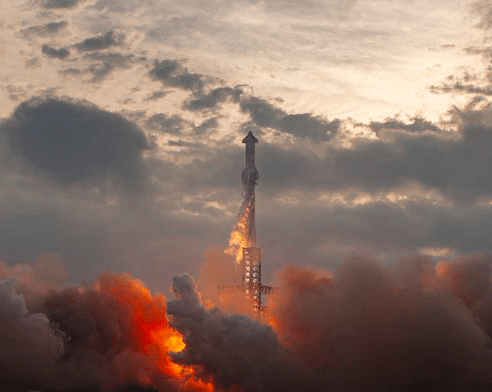
IFT-2 featured Starship SN25 and SuperHeavy Booster #9 that launched and flew the Integrated Flight Test-2 mission on November 18, 2023. Check out SpaceX's Starship Update of February 26, 2024, "Building on the Success of Starship’s Second Flight Test" to find out how SpaceX uses iterative design process to develop Starship.
+ + Get the full story of the Integrated Flight Test-2 at Astra's
IFT-1 featured Starship SN24 and SuperHeavy Booster #7 that launched and flew the Integrated Flight Test-1 mission. Launched on April 20, 2023, they flew for about 4 minutes.
+ + Get the full story of the Integrated Flight Test-1 at Astra's

Find our reviews of the upperstage prototype tests available at Astra's Stargate by clicking on the link below. Each flight is described in detail with images and links to resources.
SN15 | SN10 - SN11 | SN9 | SN8
Starhopper | SN1 - 4 | SN5 | SN6+
☆ ☆ ☆
Elon Musk posted this image of Starship workers who are busily working at Boca Chica, Texas. The image was posted on X with Musk's comment: Great work by the Starship team!
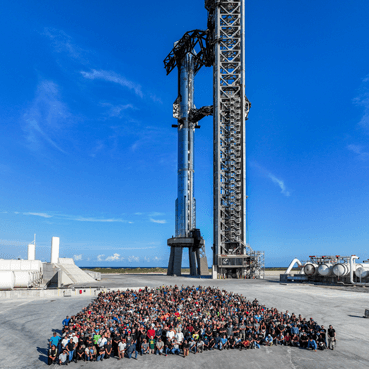
☆ ☆ ☆
Please note that many of the images on the SpaceX pages at Astra's are available at SpaceX Flickr site where they have been released into the public domain. Some have been modified to fit the available space at Stargate site by cropping and/or optimization so for best practices please use the official site. This webpage is ©2024 D. E. Jenkins all rights reserved. Please use the contact page to get permission to use this content or to send comments or corrections.
I'm a rocket fan! - - Astra
#AstrasStargate #ImaRocketFan
Astra's Stargate maintains SpaceX Information Links
Go to Astra's SpaceX Index
 Return to SpaceX - or - read Astra's request for a seat on the dearMoon mission.
Return to SpaceX - or - read Astra's request for a seat on the dearMoon mission.
Navigation at Astra's Star Gate
[ Astronomy ] [ Space ] [ StarWimin ] [ Asteroids ] [ Ancient Astronomy ] [ Observers ] [ Whats Up? almanac ]